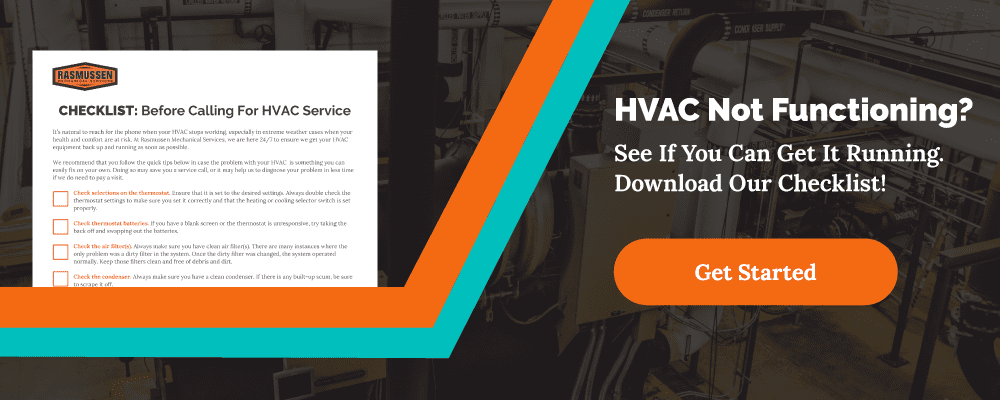You’ve been receiving complaints from your employees that they aren’t feeling well while at work. Yet, they claim to feel better once they leave, adding a further layer to this mystery.
What could be causing these issues? In reality, it isn’t that perplexing; it’s just a case of sick building syndrome.
What is “Sick Building Syndrome”, and how can it be fixed? @RasMech has the answers and more here: Click To TweetThe Problem:
Sick building syndrome (SBS) refers to when occupants feel acute discomfort that is related to the building they’re occupying.
You might not be able to identify SBS right away, and there aren’t any official medical tests for it. The real identification can be subjective, but these clues could be a dead giveaway:
- Occupants express symptoms such as headache, eye, nose, or throat irritation, nausea, dry or itchy skin, or fatigue.
- Occupants claim relief soon after leaving the building.
- Employees frequently call in sick or don’t show up at all.
- Symptoms coincide with seasonal usage of heating or cooling equipment.
Sick employees are never a good thing, but you don’t need to panic just yet… This kind of problem is more common than you’d think. It’s so familiar that the National Institute for Occupational Safety and Health (NIOSH) listed it as a “recognized health issue.”
The Cause
Once you’ve discovered that it’s the building that makes people feel sick, you need to find the root cause.
Here are a few leading causes that contribute to SBS:
- Inadequate ventilation caused by a lack of outdoor air circulation and HVAC systems not effectively distributing air.
- Chemical contaminants (volatile organic compounds) from indoor sources, such as adhesives, carpeting, upholstery, and manufactured wood products not being ventilated properly.
- Chemical contaminants from outdoor sources such as motor vehicle exhausts, plumbing vents, and building exhausts can sneak in through poorly located openings.
- Biological contaminants such as bacteria, molds, or pollen are another common cause. Sources of this may include stagnant water found in humidifiers, drain pans, and insect or bird droppings.
Of all these sources, NIOSH research found that inadequate ventilation causes the majority of all SBS cases. The likelihood of each cause being your source breaks down as follows:
- Contamination from building fabric: 4%
- Microbial contamination: 5%
- Contamination from outside of the building: 10%
- Unknown sources: 13%
- Contamination from the inside of the building: 16%
- Inadequate ventilation: 52%
If you believe you have a case of sick building syndrome, it is important to find a solution fast.
The Solution(s)
Before you can solve any problem, you need to know the cause of it. The standard method to determine what’s causing your employees to feel ill is to have a building investigation performed.
A trusted mechanical solutions provider will walk through your building to look for potential problems that could be harming your employees. Once the problem is discovered, they will come up with solutions to remediate the cause, while also applying practices to keep it from happening again.
Some of these solutions are as follows:
Pollutant source removal or modification
This quick-fix includes acts such as routine maintenance of HVAC systems, replacement of water-stained ceiling tiles or carpets and venting contaminant emissions to the outdoors. This can be an effective approach to fixing the IAQ problem.
Your building’s occupants are all expressing the same symptoms, yet feel fine once they leave. The secret behind this phenomenon might surprise you. Discover what could be making your #employees sick in @RasMech’s latest article: Click To TweetIncreasing ventilation rates
As buildings become more efficient, and air leaks are sealed, it becomes even more important to ensure there is proper ventilation. While all HVAC systems need to meet ventilation standards at minimum, they typically aren’t inspected to ensure these standards are met. A simple solution is to inspect the HVAC system to ensure it’s running at its design standard. If after inspection, rates need to be increased in areas where pollutants tend to accumulate, local exhaust ventilation will work best.
Air Filtering
This method is useful for source control and ventilation, but it does have constraints. Most furnace filters are designed to filter large particles but don’t catch smaller particles that can be the root cause of SBS. High-performance filters can catch these smaller particles but are expensive to operate because the unit has to work harder to force air through the tighter filter. When considering this option, you’ll want to be sure to find a viable solution that works best for your facility.
Education and communication
Both educating and communicating with your facility and maintenance teams can help solve your SBS issue and keep it from happening again. When all the building’s occupants are aware of the issue, they can effectively work together to solve whatever problems arise.
While sick building syndrome may seem like a big deal, there are many ways to combat it and ensure it doesn’t happen again.
Rasmussen Mechanical Services is your go-to-solution for maintaining clean air quality. Just give us a call, and we can be out to your facility to make sure your HVAC system is working the way it’s supposed to.




